Abstract
OBJECTIVE: The aim of this study were to review the experience with adenocarcinoma of the ampulla of Vater at The Johns Hopkins Hospital and to determine what factors influenced the long-term outcome in these patients. SUMMARY BACKGROUND DATA: Adenocarcinoma of the ampulla of Vater is the second most common periampullary malignancy. However, most series have relatively small numbers. As a result, analysis of factors influencing outcome has been limited. METHODS: From 1969 to 1996, 120 patients with adenocarcinoma of the ampulla of Vater were managed at The Johns Hopkins Hospital. Clinical, operative, and pathologic factors were correlated with morbidity and long-term survival. Factors influencing outcome were evaluated by univariate and multivariate analyses. RESULTS: Resection was performed in 106 patients (88%), and 105 of these patients (99%) underwent either pancreatoduodenal resection (n = 103) or total pancreatectomy (n = 2). Resection rate increased from 62% in the 1970s to 82% in the 1980s to 96% in the 1990s (p < 0.05). Overall mortality after resection was 3.8% with no mortality in the 45 consecutive patients resected in the past 5 years. Morbidity also decreased significantly (p < 0.05) from 70% before to 38% after December 1992. Five-year survival for resected patient was 38%. Factors favorably influencing long-term outcome were resection (p < 0.001), no perioperative blood transfusions (p < 0.05), negative lymph node status (p = 0.05), and moderate or well-differentiated tumors (p < 0.05). In a multivariate analysis, the best predictor of prolonged survival was absence of intraoperative transfusion (p = 0.06, relative risk = 1.90, 95% confidence limits = 0.95-3.78). CONCLUSIONS: Compared to carcinoma of the pancreas, carcinoma of the ampulla of Vater has a higher resectability rate and a better prognosis. Early diagnosis is important because lymph node status influences survival. Careful operative dissection and avoidance of transfusions also improves long-term survival.
Full text
PDF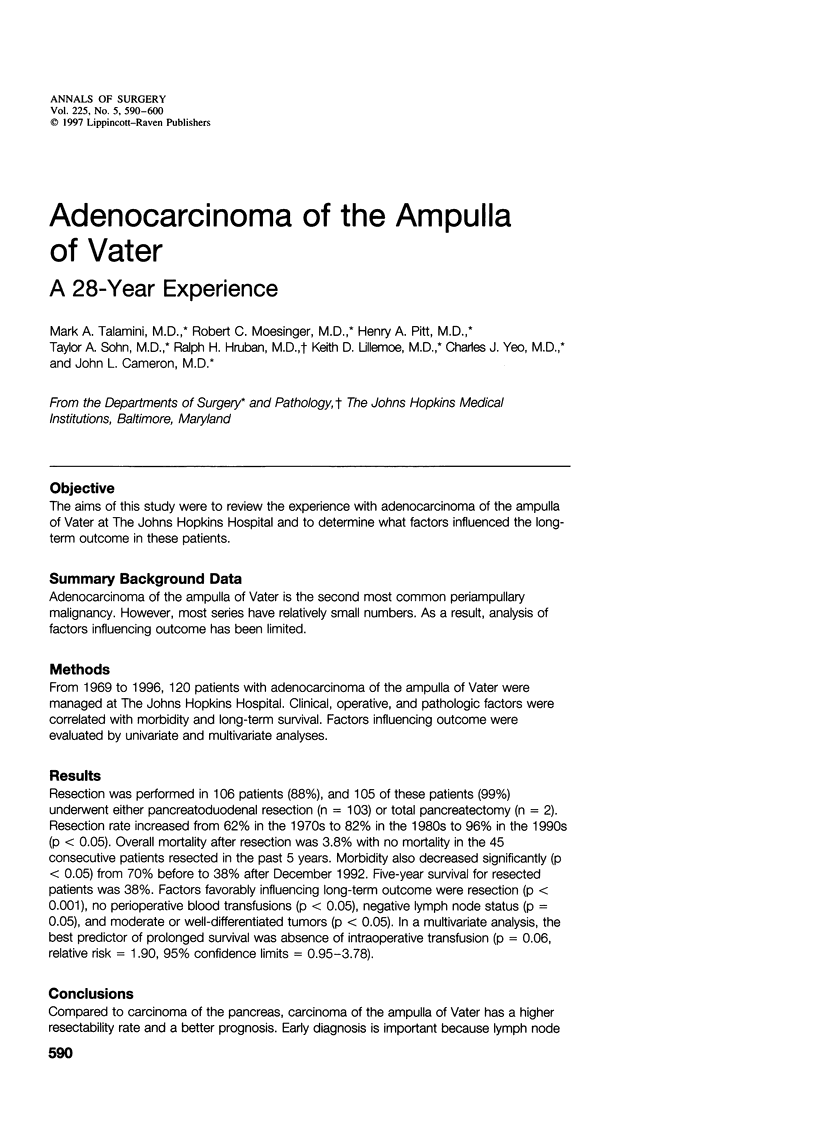
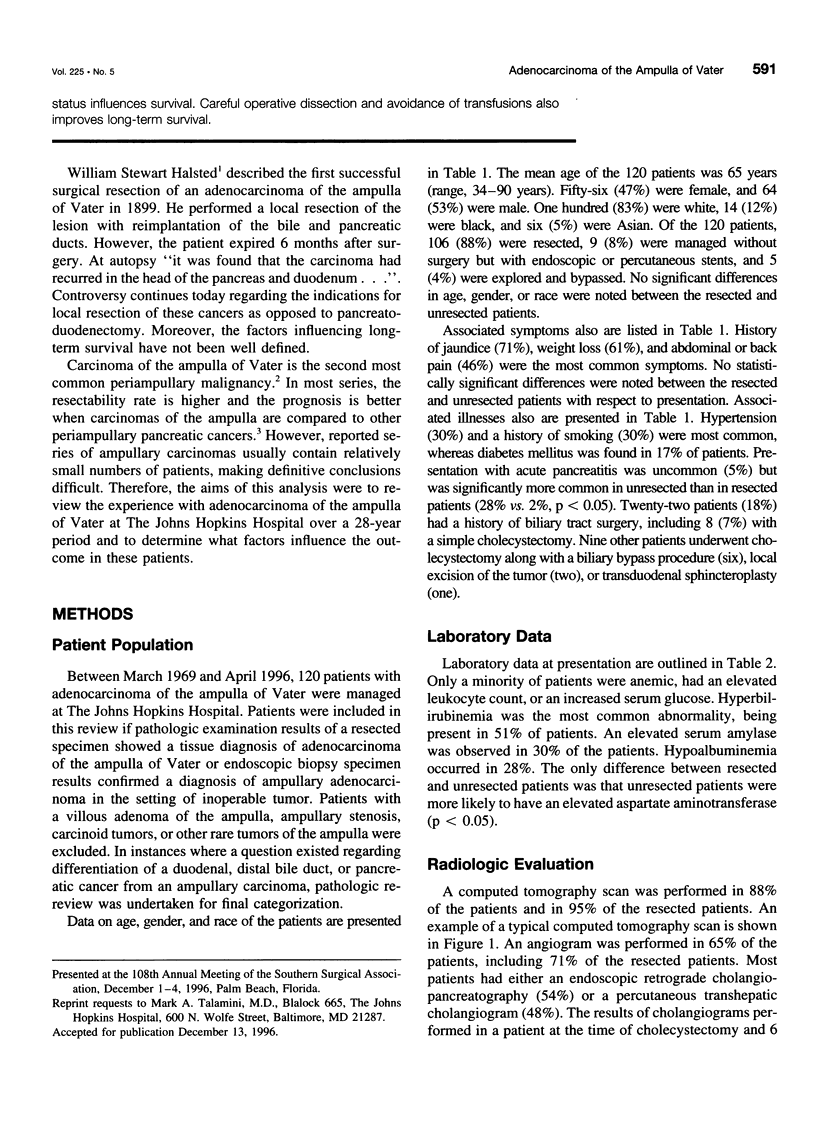
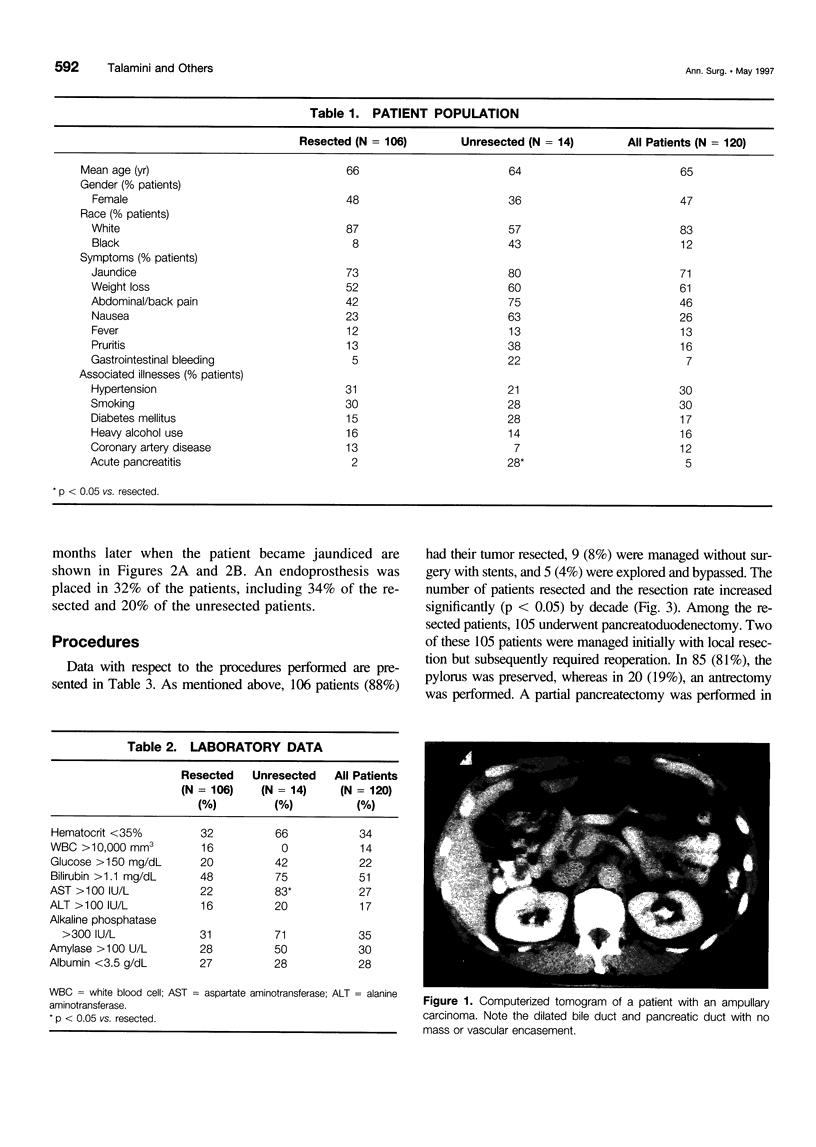


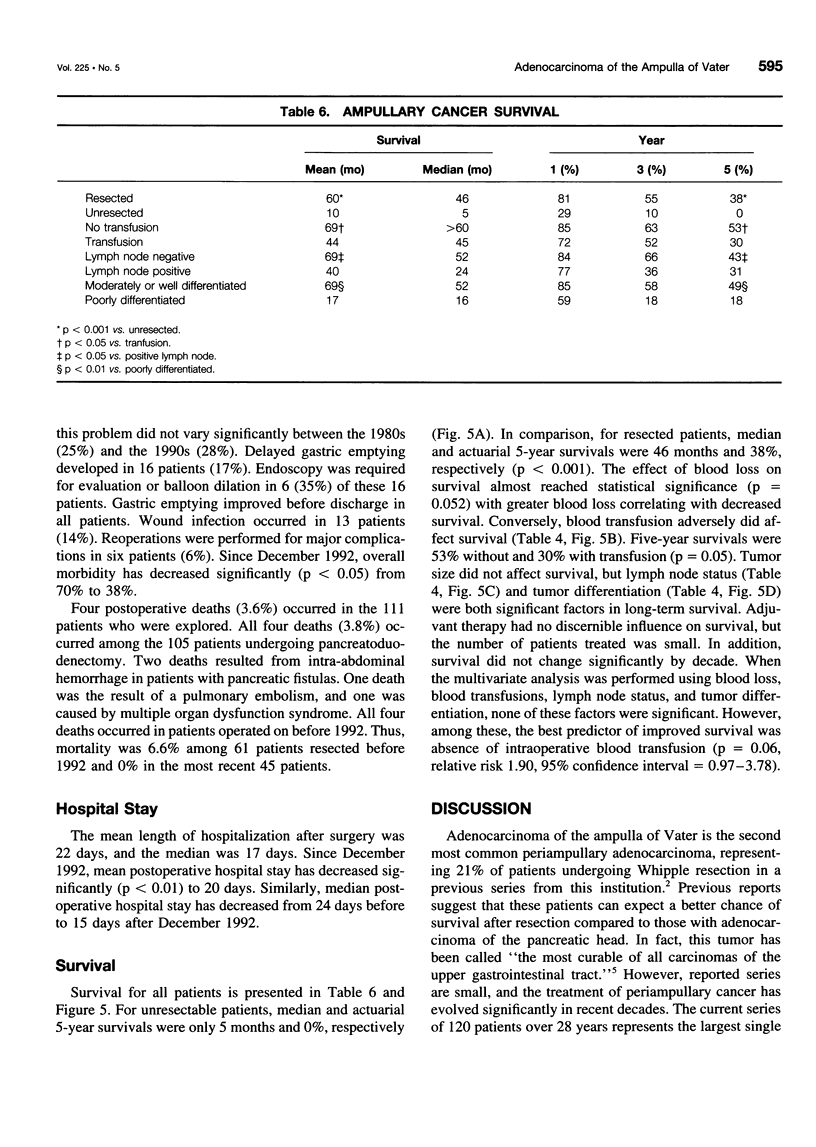
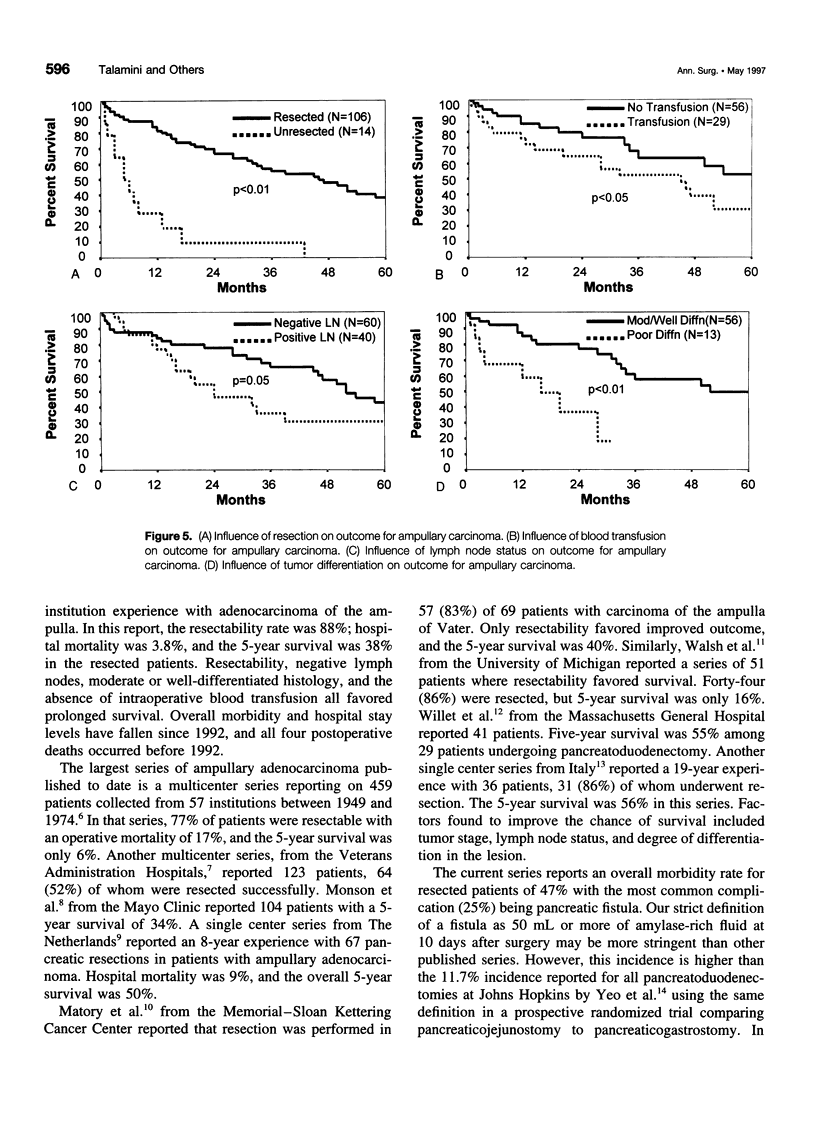
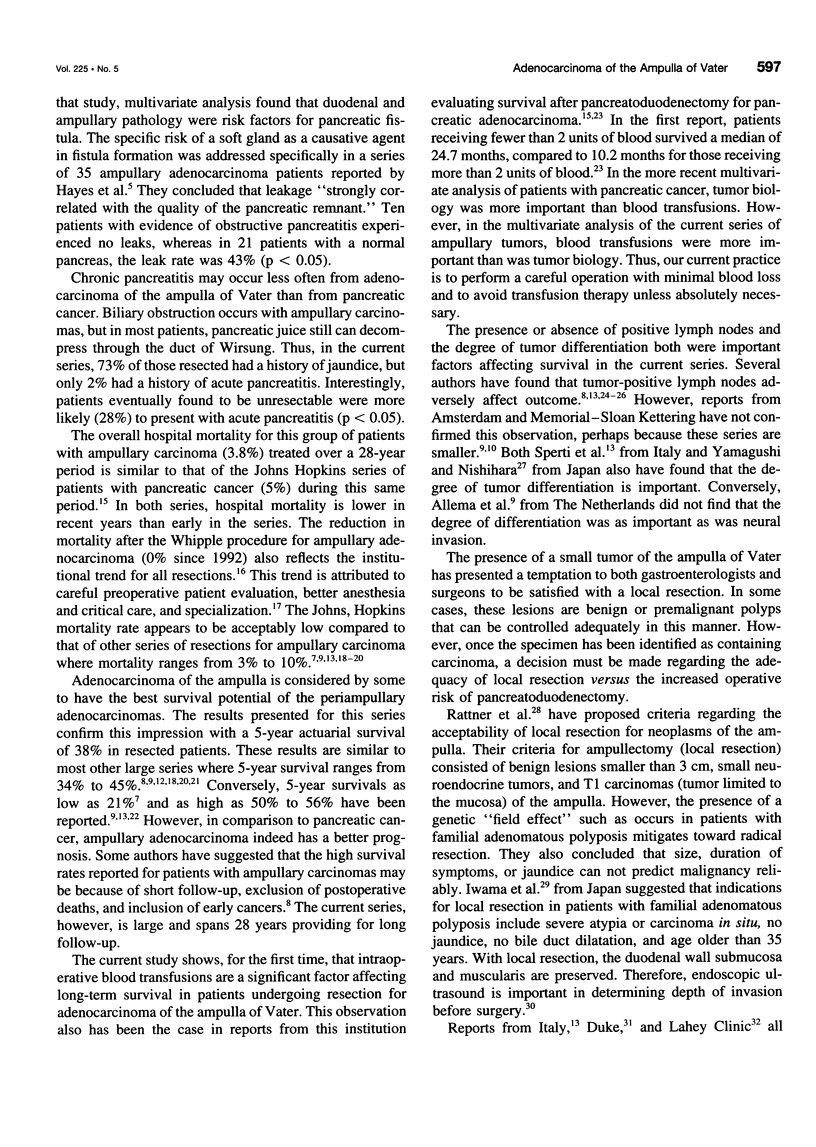
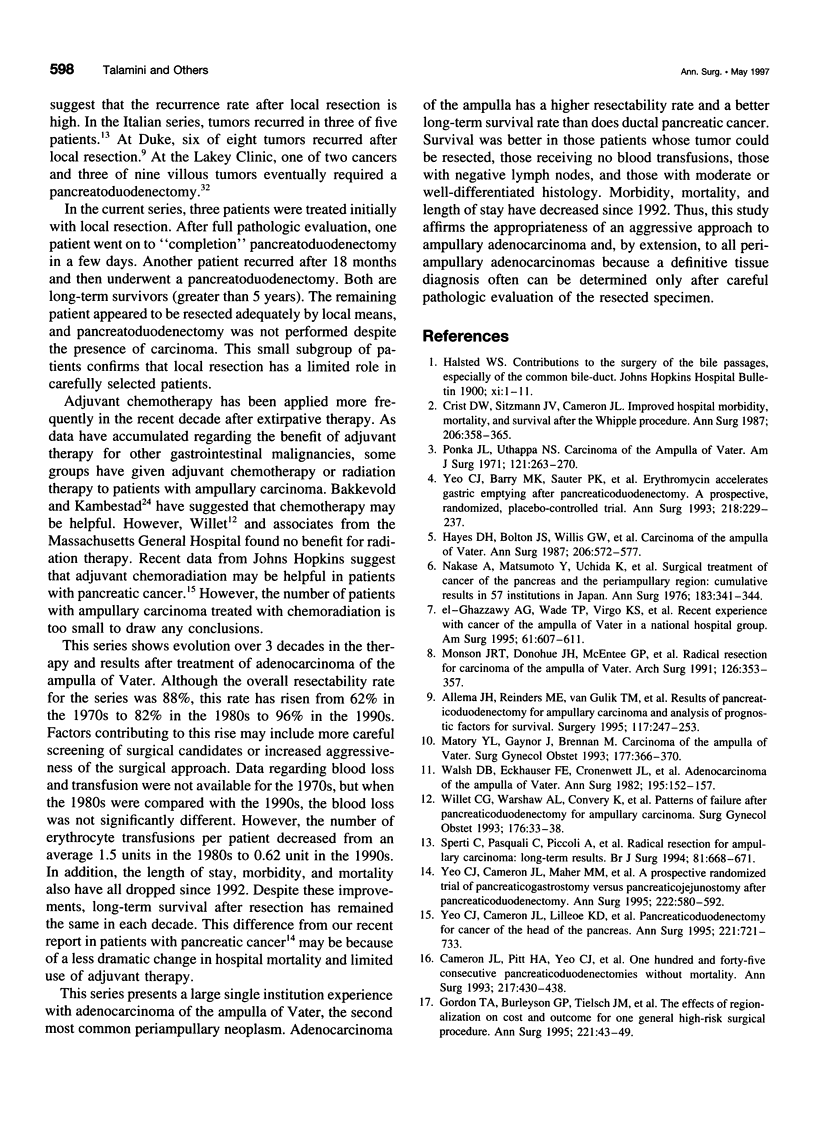
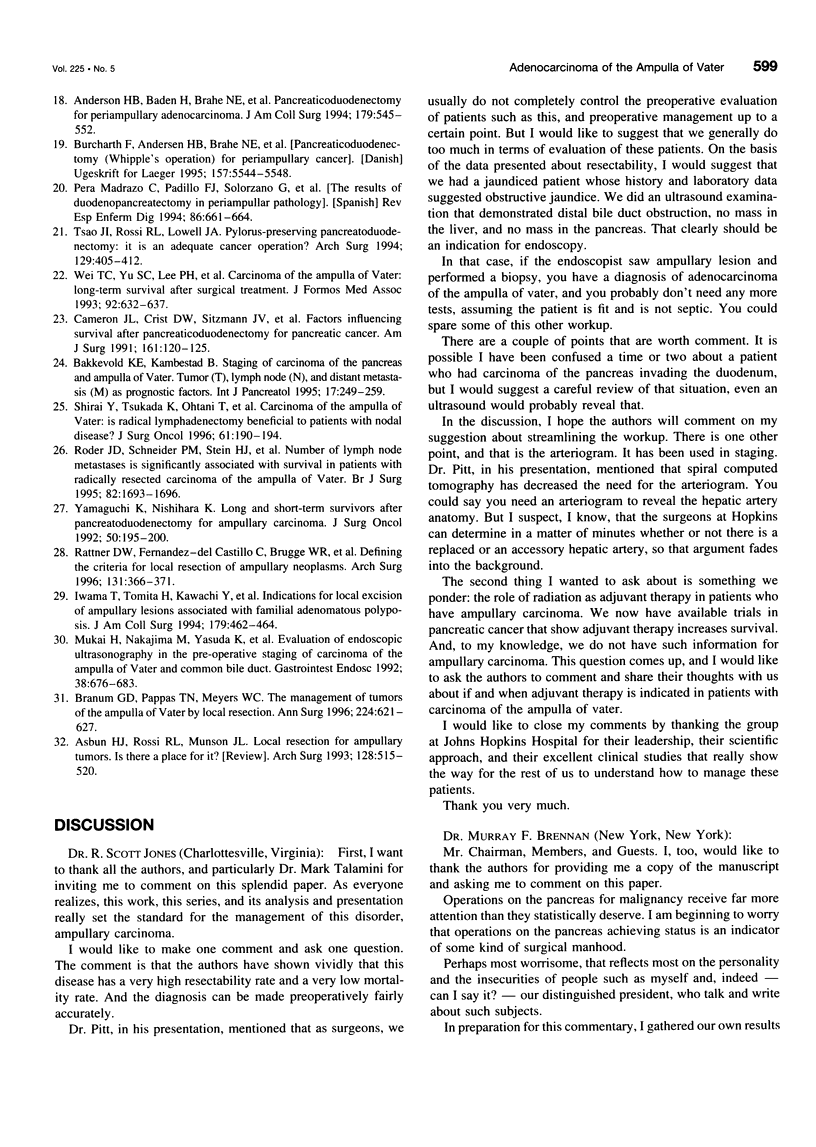
Images in this article
Selected References
These references are in PubMed. This may not be the complete list of references from this article.
- Allema J. H., Reinders M. E., van Gulik T. M., van Leeuwen D. J., Verbeek P. C., de Wit L. T., Gouma D. J. Results of pancreaticoduodenectomy for ampullary carcinoma and analysis of prognostic factors for survival. Surgery. 1995 Mar;117(3):247–253. doi: 10.1016/s0039-6060(05)80197-7. [DOI] [PubMed] [Google Scholar]
- Andersen H. B., Baden H., Brahe N. E., Burcharth F. Pancreaticoduodenectomy for periampullary adenocarcinoma. J Am Coll Surg. 1994 Nov;179(5):545–552. [PubMed] [Google Scholar]
- Asbun H. J., Rossi R. L., Munson J. L. Local resection for ampullary tumors. Is there a place for it? Arch Surg. 1993 May;128(5):515–520. doi: 10.1001/archsurg.1993.01420170045006. [DOI] [PubMed] [Google Scholar]
- Bakkevold K. E., Kambestad B. Staging of carcinoma of the pancreas and ampulla of Vater. Tumor (T), lymph node (N), and distant metastasis (M) as prognostic factors. Int J Pancreatol. 1995 Jun;17(3):249–259. doi: 10.1007/BF02785822. [DOI] [PubMed] [Google Scholar]
- Branum G. D., Pappas T. N., Meyers W. C. The management of tumors of the ampulla of Vater by local resection. Ann Surg. 1996 Nov;224(5):621–627. doi: 10.1097/00000658-199611000-00006. [DOI] [PMC free article] [PubMed] [Google Scholar]
- Burcharth F., Andersen H. B., Brahe N. E., Baden H. Pankreatikoduodenektomi (Whipples operation) for periampullaer cancer. Ugeskr Laeger. 1995 Oct 2;157(40):5544–5548. [PubMed] [Google Scholar]
- Cameron J. L., Crist D. W., Sitzmann J. V., Hruban R. H., Boitnott J. K., Seidler A. J., Coleman J. Factors influencing survival after pancreaticoduodenectomy for pancreatic cancer. Am J Surg. 1991 Jan;161(1):120–125. doi: 10.1016/0002-9610(91)90371-j. [DOI] [PubMed] [Google Scholar]
- Cameron J. L., Pitt H. A., Yeo C. J., Lillemoe K. D., Kaufman H. S., Coleman J. One hundred and forty-five consecutive pancreaticoduodenectomies without mortality. Ann Surg. 1993 May;217(5):430–438. doi: 10.1097/00000658-199305010-00002. [DOI] [PMC free article] [PubMed] [Google Scholar]
- Crist D. W., Sitzmann J. V., Cameron J. L. Improved hospital morbidity, mortality, and survival after the Whipple procedure. Ann Surg. 1987 Sep;206(3):358–365. doi: 10.1097/00000658-198709000-00014. [DOI] [PMC free article] [PubMed] [Google Scholar]
- Gordon T. A., Burleyson G. P., Tielsch J. M., Cameron J. L. The effects of regionalization on cost and outcome for one general high-risk surgical procedure. Ann Surg. 1995 Jan;221(1):43–49. doi: 10.1097/00000658-199501000-00005. [DOI] [PMC free article] [PubMed] [Google Scholar]
- Hayes D. H., Bolton J. S., Willis G. W., Bowen J. C. Carcinoma of the ampulla of Vater. Ann Surg. 1987 Nov;206(5):572–577. doi: 10.1097/00000658-198711000-00003. [DOI] [PMC free article] [PubMed] [Google Scholar]
- Iwama T., Tomita H., Kawachi Y., Yoshinaga K., Kume S., Maruyama H., Mishima Y. Indications for local excision of ampullary lesions associated with familial adenomatous polyposis. J Am Coll Surg. 1994 Oct;179(4):462–464. [PubMed] [Google Scholar]
- Makipour H., Cooperman A., Danzi J. T., Farmer R. G. Carcinoma of the ampulla of Vater: Review of 38 cases with emphasis on treatment and prognostic factors. Ann Surg. 1976 Apr;183(4):341–344. doi: 10.1097/00000658-197604000-00002. [DOI] [PMC free article] [PubMed] [Google Scholar]
- Matory Y. L., Gaynor J., Brennan M. Carcinoma of the ampulla of Vater. Surg Gynecol Obstet. 1993 Oct;177(4):366–370. [PubMed] [Google Scholar]
- Monson J. R., Donohue J. H., McEntee G. P., McIlrath D. C., van Heerden J. A., Shorter R. G., Nagorney D. M., Ilstrup D. M. Radical resection for carcinoma of the ampulla of Vater. Arch Surg. 1991 Mar;126(3):353–357. doi: 10.1001/archsurg.1991.01410270099016. [DOI] [PubMed] [Google Scholar]
- Mukai H., Nakajima M., Yasuda K., Mizuno S., Kawai K. Evaluation of endoscopic ultrasonography in the pre-operative staging of carcinoma of the ampulla of Vater and common bile duct. Gastrointest Endosc. 1992 Nov-Dec;38(6):676–683. doi: 10.1016/s0016-5107(92)70563-x. [DOI] [PubMed] [Google Scholar]
- Ponka J. L., Uthappa N. S. Carcinoma of the ampulla of Vater. Am J Surg. 1971 Mar;121(3):263–270. doi: 10.1016/0002-9610(71)90202-9. [DOI] [PubMed] [Google Scholar]
- Rattner D. W., Fernandez-del Castillo C., Brugge W. R., Warshaw A. L. Defining the criteria for local resection of ampullary neoplasms. Arch Surg. 1996 Apr;131(4):366–371. doi: 10.1001/archsurg.1996.01430160024003. [DOI] [PubMed] [Google Scholar]
- Roder J. D., Schneider P. M., Stein H. J., Siewert J. R. Number of lymph node metastases is significantly associated with survival in patients with radically resected carcinoma of the ampulla of Vater. Br J Surg. 1995 Dec;82(12):1693–1696. doi: 10.1002/bjs.1800821235. [DOI] [PubMed] [Google Scholar]
- Shirai Y., Tsukada K., Ohtani T., Hatakeyama K. Carcinoma of the ampulla of Vater: is radical lymphadenectomy beneficial to patients with nodal disease? J Surg Oncol. 1996 Mar;61(3):190–194. doi: 10.1002/(SICI)1096-9098(199603)61:3<190::AID-JSO5>3.0.CO;2-6. [DOI] [PubMed] [Google Scholar]
- Sperti C., Pasquali C., Piccoli A., Sernagiotto C., Pedrazzoli S. Radical resection for ampullary carcinoma: long-term results. Br J Surg. 1994 May;81(5):668–671. doi: 10.1002/bjs.1800810512. [DOI] [PubMed] [Google Scholar]
- Tsao J. I., Rossi R. L., Lowell J. A. Pylorus-preserving pancreatoduodenectomy. Is it an adequate cancer operation. Arch Surg. 1994 Apr;129(4):405–412. doi: 10.1001/archsurg.1994.01420280081010. [DOI] [PubMed] [Google Scholar]
- Walsh D. B., Eckhauser F. E., Cronenwett J. L., Turcotte J. G., Lindenauer S. M. Adenocarcinoma of the ampulla of Vater. Diagnosis and treatment. Ann Surg. 1982 Feb;195(2):152–157. doi: 10.1097/00000658-198202000-00005. [DOI] [PMC free article] [PubMed] [Google Scholar]
- Wei T. C., Yu S. C., Lee P. H., Hsu S. C. Carcinoma of the ampulla of Vater: long-term survival after surgical treatment. J Formos Med Assoc. 1993 Jul;92(7):632–637. [PubMed] [Google Scholar]
- Willett C. G., Warshaw A. L., Convery K., Compton C. C. Patterns of failure after pancreaticoduodenectomy for ampullary carcinoma. Surg Gynecol Obstet. 1993 Jan;176(1):33–38. [PubMed] [Google Scholar]
- Yamaguchi K., Nishihara K. Long- and short-term survivors after pancreatoduodenectomy for ampullary carcinoma. J Surg Oncol. 1992 Jul;50(3):195–200. doi: 10.1002/jso.2930500314. [DOI] [PubMed] [Google Scholar]
- Yeo C. J., Barry M. K., Sauter P. K., Sostre S., Lillemoe K. D., Pitt H. A., Cameron J. L. Erythromycin accelerates gastric emptying after pancreaticoduodenectomy. A prospective, randomized, placebo-controlled trial. Ann Surg. 1993 Sep;218(3):229–238. doi: 10.1097/00000658-199309000-00002. [DOI] [PMC free article] [PubMed] [Google Scholar]
- Yeo C. J., Cameron J. L., Lillemoe K. D., Sitzmann J. V., Hruban R. H., Goodman S. N., Dooley W. C., Coleman J., Pitt H. A. Pancreaticoduodenectomy for cancer of the head of the pancreas. 201 patients. Ann Surg. 1995 Jun;221(6):721–733. doi: 10.1097/00000658-199506000-00011. [DOI] [PMC free article] [PubMed] [Google Scholar]
- Yeo C. J., Cameron J. L., Maher M. M., Sauter P. K., Zahurak M. L., Talamini M. A., Lillemoe K. D., Pitt H. A. A prospective randomized trial of pancreaticogastrostomy versus pancreaticojejunostomy after pancreaticoduodenectomy. Ann Surg. 1995 Oct;222(4):580–592. doi: 10.1097/00000658-199510000-00014. [DOI] [PMC free article] [PubMed] [Google Scholar]
- el-Ghazzawy A. G., Wade T. P., Virgo K. S., Johnson F. E. Recent experience with cancer of the ampulla of Vater in a national hospital group. Am Surg. 1995 Jul;61(7):607–611. [PubMed] [Google Scholar]





